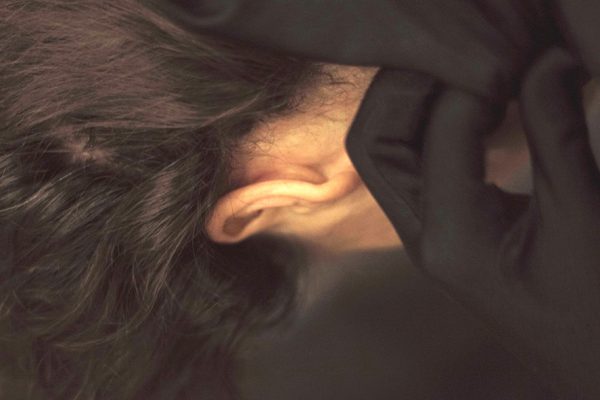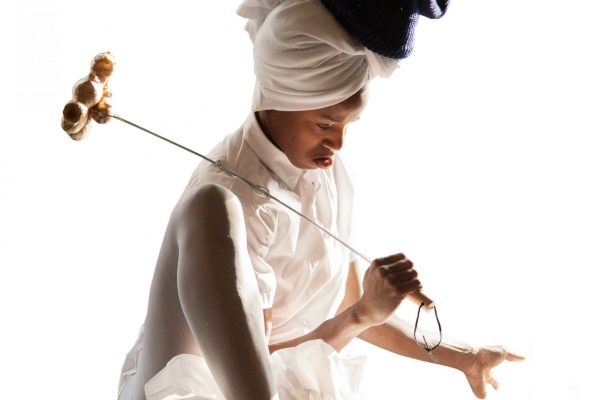Through the backstage area, we tiptoe in our socks into L’Agora de la danse. It has become a de facto gallery space for the performance of Culture, Administration & Trembling. Europe-based, North American choreographers Antonija Livingstone and Jennifer Lacey, with Dominique Pétrin and Stephen Thompson, are at once its curators and its artists. Dispersing ourselves around the perimeter of the room, we slow down to the languid rhythm of silky dancer-bodies moving feline-like on all fours. All the people who will eventually join the performance are scattered among us.
Culture builds up in slow layers. It works deeply on my nervous system. As in a Feldenkrais lesson — where resting is integral to the assimilation of new neuromuscular connections and sensations — I settle into the duration of each image to absorb its potential. Most of these tableaux last and last, and I find this incredibly soothing. The sounds of harmonized handbells, the behaviours of snakes and chihuahuas, the empathetic offering of nipples in a vignette of couples who mock-breastfeed each other (exhaling into the chest of their partners, their bottoms cupped by their mother-twin, arms slung over a shoulder in a congruent exchange of deep relaxation) … these events calm my sympathetic nervous system.
The white Marley covering the ground is an intimate space we share. It’s the gallery wall we take in. Montréal visual artist Dominique Pétrin has her two hands in a bucket of glue, pasting neon-coloured origami paper to the floor in diamond patterns. That kind of tactility is present everywhere in Culture: and applies to feet, scalps, breasts, bellies and paws.
My writer persona wants to connect the dots between the contrasting sections of the performance, which range from nearly still physical sculptures to Stephen Thompson’s virtuosic figure skating without skates. Thematically, I’d like to link “animal” to “mammal,” “mammal” to “mammary,” “harmonics” to “humanity” and string anthropological themes together. I suspect, however, that — in my role as witness to all this — an attempt to bring narrative cohesion to the multifaceted creation is superfluous. It is beyond my knowledge of critical theory to speak to the underpinning of the piece (Livingstone and Lacey borrowed the title from a text by German Frankfurt School theorist Theodor W. Adorno, first using it for a 2009 duet), but that doesn’t detract from the pleasures of my experience.
I enjoy seeing a community encircle the stage — dancers, curators, critics, doctors and unfamiliar faces of curious spectators who’ve come together to perform the crucial role of Audience. The performers form a large community, too, and the borders between us are thin: we blend into one another. The commune of the performers extends to a cast of characters of different callings and sizes with piercings, a circus of animals. The dancers are Rainer-esque and subtly discard performative pretensions. They blow their noses as they need, cough, speak to each other and accept their imperfections and un-synchronicities. Yes, there are token bits of irony and academia that tether the piece to a certain brand of contemporary performance, but most of the space is taken up by empathy, investment and art-making. And that makes me feel very good.
In its costumes and set design, Culture is vulnerable to pick-pocketing by Urban Outfitters, but there is also enough risk-taking and integrity in the performance to annul what would be considered a “hipster” aesthetic elsewhere. I see humans invested in carrying something somewhere; I receive sensations.
It doesn’t surprise me that half of the audience has left by the time the “male breastfeeding” scene is complete. Their intimacy, tender gazes toward each other, the delicacy and deliberateness of their care for one another, have certain qualities of an autonomous sensory meridian response video: not everyone gets the spine chills and head tingles associated with paying attention to detail, subtlety and repetition.
My attention is held always by something — something is always giving me sensation as I watch. I don’t necessarily catch all the political underpinnings, but I am unhurried and that brings its own rewards.
Tagged: Choreography, Contemporary, Performance, Stephen Thompson, Montréal , QC





